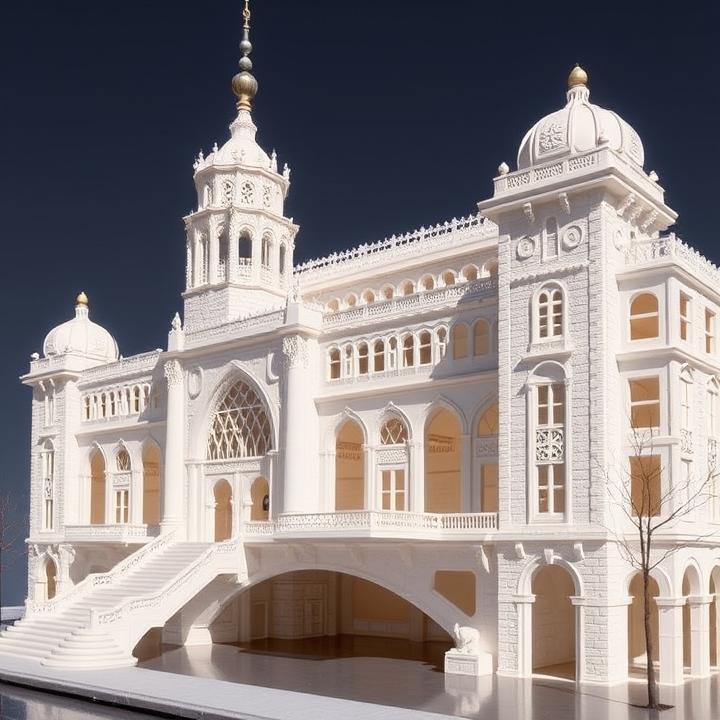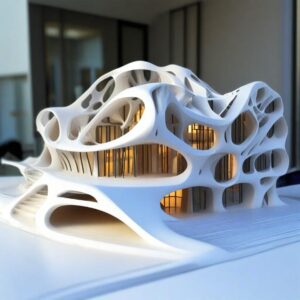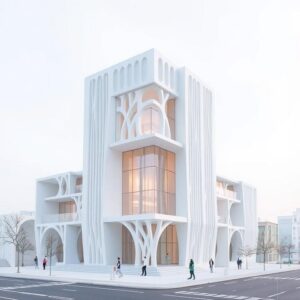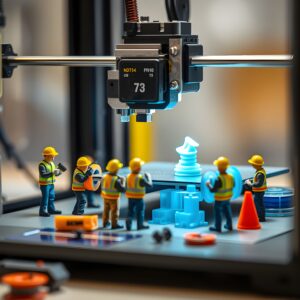How 3D Printing is Shaping the Future of Architecture: Case Studies, Benefits, and Insights

Explore the impact of 3D printing in architecture, from design innovation to sustainable construction. Learn how cutting-edge technologies are changing the landscape of buildings and urban planning.
The Impact of 3D Printing on Architecture
3D printing, also known as additive manufacturing, is disrupting industries across the globe, and architecture is no exception. As architects and builders look for innovative ways to create sustainable, cost-effective, and aesthetically unique designs, 3D printing has emerged as a powerful tool in the architectural world.

From designing intricate, highly customized buildings to constructing entire structures with minimal waste, 3D printing is revolutionizing the way architects, engineers, and construction professionals work. This article will explore how 3D printing is transforming architecture, with a focus on five groundbreaking case studies that highlight the diverse ways this technology is being used in design, construction, and urban planning.
Case Study 1: The 3D-Printed Office in Dubai: A Landmark in Construction
One of the most notable examples of 3D printing in architecture is the 3D-printed office building in Dubai. Completed in 2016, the building stands as a symbol of the potential for 3D printing to revolutionize the construction industry.
Dubai’s 3D-Printed Office: A World First
The office, located in the Dubai International Financial Centre (DIFC), was built using a large-scale 3D printer, which printed the structure layer by layer. The design was created using 3D modeling software, and the printer used a combination of concrete, gypsum, and other materials to construct the building. The building itself features intricate designs and unique shapes that would be difficult or impossible to achieve using traditional construction methods.
Benefits and Results
The construction of this office took only 17 days, a fraction of the time that would typically be required for conventional methods. Additionally, the building was 60% cheaper to construct than a traditional office building of the same size. The project demonstrated the potential of 3D printing to reduce construction time, lower costs, and reduce material waste, making it a groundbreaking achievement in the field of architecture.
This project also sparked interest in the broader use of 3D printing in the construction industry, leading to increased investments and research into 3D-printed homes, offices, and other buildings.
Case Study 2: 3D-Printed Housing in Mexico A Solution for Affordable Homes
In Mexico, a nonprofit organization called New Story has partnered with ICON, a construction technology company, to build affordable homes using 3D printing. The aim of the project is to tackle the housing crisis by creating durable, cost-effective homes for families in need.
3D-Printed Homes in Tabasco, Mexico
In 2020, ICON used its Vulcan 3D printer to construct homes in the city of Tabasco, Mexico. These homes were built with concrete and other sustainable materials, designed to be safe, comfortable, and affordable. The construction process involves using the 3D printer to print the walls layer by layer, ensuring minimal waste and faster construction times compared to traditional methods.
Results and Impact
The 3D-printed homes are expected to cost 50% less than traditional construction methods, offering a feasible solution for addressing the housing needs of low-income families. The project has already received attention from global organizations as a potential model for affordable housing in developing countries. ICON and New Story continue to expand this project, with plans for additional homes in other regions of Mexico.
This initiative has the potential to reshape the housing market by providing low-cost, high-quality homes to those who need them most, while also minimizing the environmental impact of construction.
Case Study 3: The 3D-Printed Concrete Bridge in the Netherlands A Leap Forward in Infrastructure
In the Netherlands, a team of engineers and architects has successfully built the world’s first 3D-printed concrete bridge, a significant milestone in the use of 3D printing for infrastructure projects.
3D-Printed Bridge in Gemert, Netherlands
Completed in 2020, the bridge in Gemert was created using a 3D concrete printer capable of printing large-scale structures. The bridge was designed to be both functional and aesthetically pleasing, featuring intricate geometric patterns. It was printed using a mix of concrete and reinforcement materials, which were layered to form the bridge’s structure.
Results and Benefits
The 3D-printed bridge is designed to be more durable and cost-effective than traditional concrete bridges. It was completed in a fraction of the time it would take using conventional methods and uses far fewer materials, reducing the overall environmental impact of the project. The successful completion of this bridge has opened up new possibilities for using 3D printing in infrastructure projects, including pedestrian bridges, roadways, and public art installations.
This project has highlighted the potential for 3D printing to revolutionize infrastructure by providing a faster, more sustainable, and more cost-effective alternative to traditional construction methods.
Case Study 4: The 3D-Printed Pavilion in the United Kingdom: Innovative Design Meets Sustainability
The University of London partnered with a team of architects and engineers to create a 3D-printed pavilion that combines innovative design with sustainable materials. This project sought to explore how 3D printing can be used to create public spaces that are both functional and environmentally friendly.
3D-Printed Pavilion at the University of London
The pavilion, completed in 2018, was created using a combination of recycled materials, including biodegradable plastics. The design features a complex lattice structure, which was optimized for both aesthetics and performance. The project aimed to showcase how 3D printing can be used to create sustainable, energy-efficient structures that have a minimal impact on the environment.
Benefits and Results
The pavilion’s innovative design was not only a visually striking public space but also demonstrated the potential for 3D printing to reduce waste and carbon emissions. The use of biodegradable materials further enhanced the sustainability aspect of the project, showcasing how 3D printing can be combined with sustainable architecture to create eco-friendly buildings.
The pavilion serves as an educational tool, raising awareness about the possibilities of sustainable 3D printing and inspiring future projects that use 3D printing to address the challenges of climate change and resource scarcity.
Case Study 5: 3D-Printed Skyscrapers in China: Scaling Up for the Future of Urban Planning
In China, a team of architects and urban planners is working to create the world’s first 3D-printed skyscrapers, aimed at addressing the growing need for urban housing and commercial space in the country’s rapidly expanding cities.
3D-Printed Skyscrapers in Shanghai
Using large-scale 3D printers, the team in Shanghai is working to create multi-story buildings that can be quickly printed and assembled on-site. The project aims to integrate 3D printing with other modern construction techniques, such as modular design and sustainable materials, to create skyscrapers that are not only faster to build but also more energy-efficient and environmentally friendly.
Results and Benefits
The 3D-printed skyscrapers are designed to be cost-effective, with significant reductions in labor and material costs compared to traditional skyscraper construction. These buildings will also feature energy-efficient systems and green technologies, such as solar panels and water-saving plumbing.
Once completed, the skyscrapers will serve as a model for future urban development in China and around the world, providing a more sustainable and scalable solution for housing and commercial space in crowded cities.
The Benefits of 3D Printing in Architecture
1. Faster Construction Times
One of the most significant advantages of 3D printing in architecture is the reduction in construction time. Projects like the 3D-printed office in Dubai or the 3D-printed bridge in the Netherlands demonstrate how 3D printing can significantly reduce the time it takes to complete a building or infrastructure project.
2. Cost Reduction
3D printing allows for greater control over material usage, minimizing waste and reducing costs. By using digital models, construction teams can ensure that materials are used efficiently and complex designs can be created without the need for expensive molds or labor-intensive processes.
3. Sustainability and Waste Reduction
3D printing reduces the amount of material waste produced during construction. The additive nature of 3D printing ensures that only the necessary material is used, unlike traditional methods that often result in excess waste. Additionally, 3D printing allows for the use of sustainable materials, such as recycled plastics and biodegradable concrete.
4. Design Freedom and Customization
3D printing offers architects the freedom to design complex, intricate structures that would be difficult or impossible to create using traditional construction methods. This opens up new possibilities for creative and unique designs in buildings, bridges, and urban spaces.
5. Improved Sustainability
3D-printed buildings can incorporate sustainable technologies, such as energy-efficient insulation, solar panels, and rainwater harvesting systems. This helps reduce the environmental footprint of construction projects and promotes a greener future for urban development.
Frequently Asked Questions (FAQs)
Q1: How does 3D printing reduce construction costs?
A: 3D printing reduces costs by minimizing waste, speeding up construction times, and reducing the need for expensive molds or specialized labor.
Q2: What materials can be used in 3D printing for architecture?
A: Common materials include concrete, biodegradable plastics, metal alloys, and recycled materials, depending on the type of project.
Q3: How long does it take to build a 3D-printed structure?
A: Construction times vary, but 3D-printed structures can often be completed in a fraction of the time compared to traditional construction, such as the Dubai office, which took just 17 days.
Q4: Are 3D-printed buildings as strong as traditional buildings?
A: Yes, 3D-printed buildings are made with durable materials like concrete and metal alloys, which provide strength comparable to traditional buildings.
Q5: Can 3D printing be used for large-scale buildings?
Yes, large-scale 3D printing is possible, as demonstrated by the construction of 3D-printed skyscrapers and multi-story buildings in China.
Q6: How does 3D printing benefit the environment?
3D printing reduces material waste, minimizes carbon emissions, and allows for the use of sustainable materials, making it an eco-friendly construction method.
Q7: Is 3D printing in architecture affordable?
While initial investments in 3D printers and technology can be expensive, the long-term savings in material costs and construction time make 3D printing a cost-effective option.
Q8: What are the limitations of 3D printing in architecture?
A: Limitations include the need for specialized equipment, the size restrictions of printers, and the initial investment in technology.
Q9: How is 3D printing being used in urban planning?
3D printing is used in urban planning to create models of buildings and entire city layouts, helping architects and planners visualize and test their designs.
Q10: What is the future of 3D printing in architecture?
The future of 3D printing in architecture includes wider adoption of 3D-printed homes, bridges, and skyscrapers, with continued advancements in materials and construction technologies.
The Future of 3D Printing in Architecture
3D printing is changing the face of architecture, offering new possibilities for design, construction, and urban planning. With its ability to reduce costs, minimize waste, and provide innovative solutions to complex problems, 3D printing is poised to play a major role in the future of architecture. As the technology continues to evolve, it will be exciting to see how it transforms cities, buildings, and public spaces around the world.




